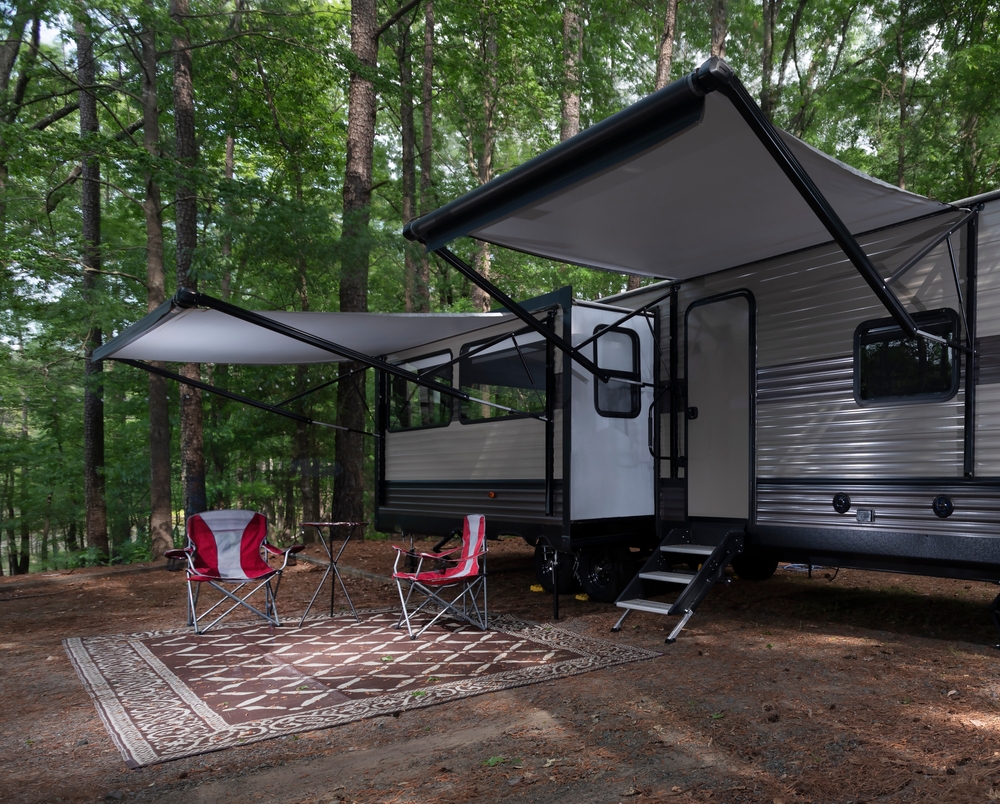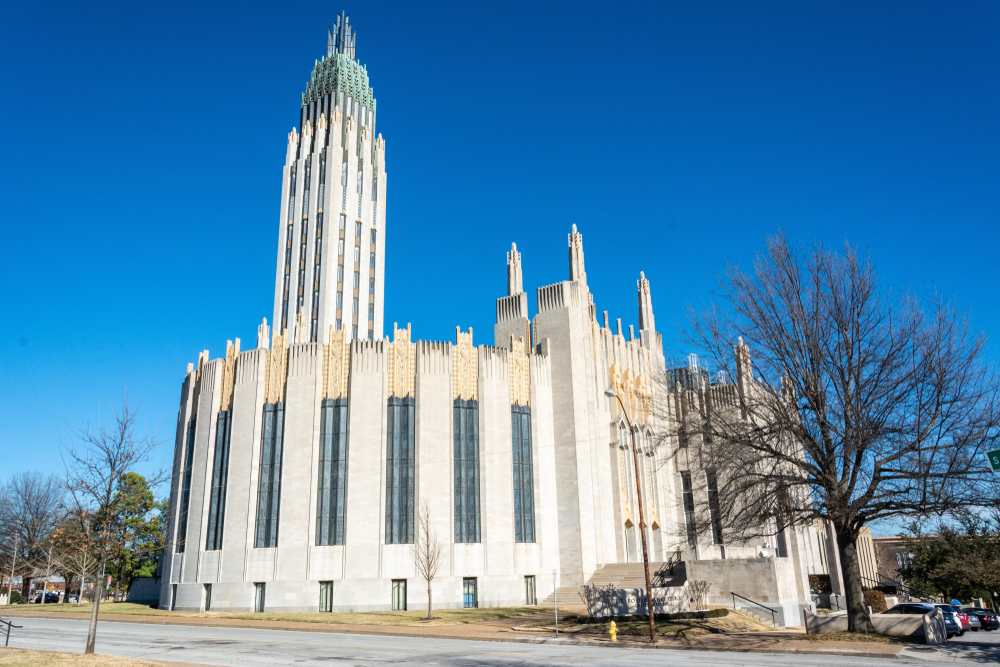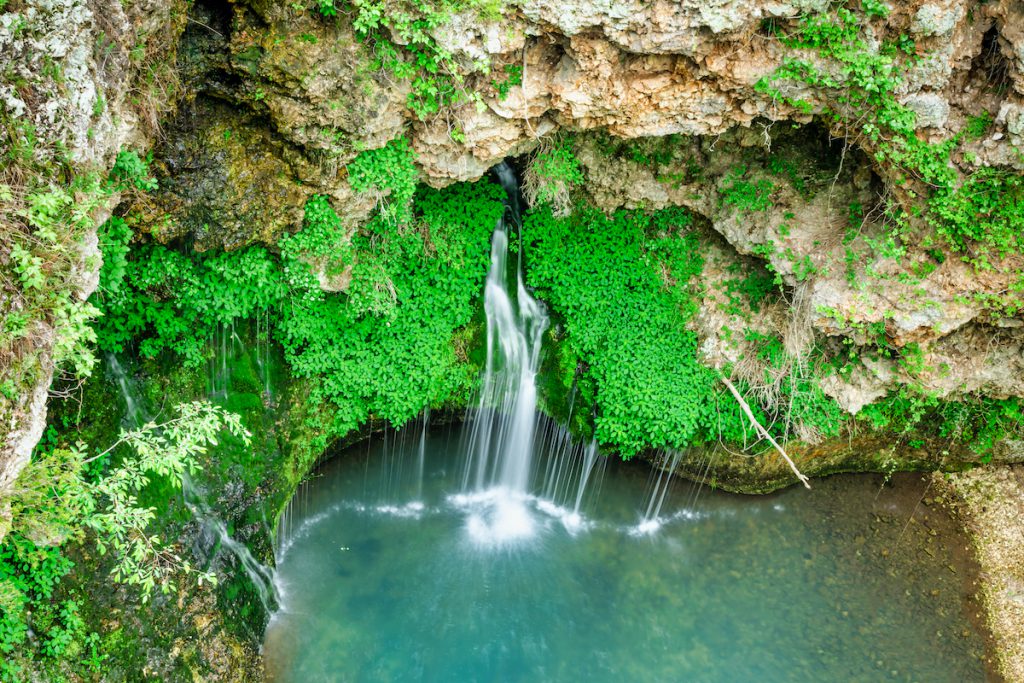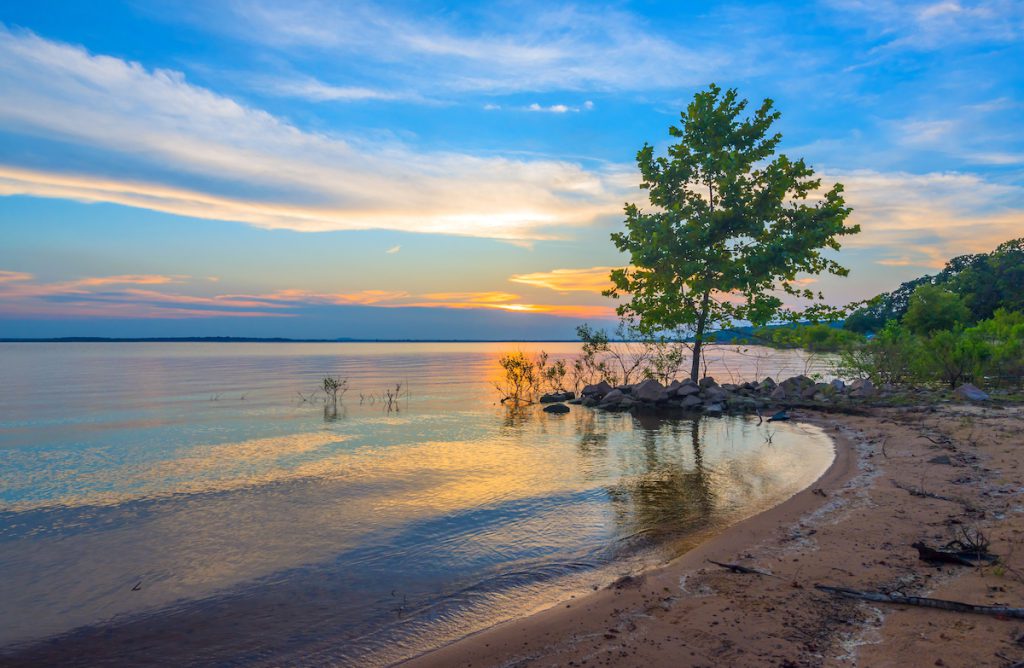
Heading to Oklahoma? RV camping in Oklahoma is a great way to see the state. You can travel through all of Oklahoma in comfort, stopping in cities, natural areas, and other places of interest while still traveling with everything you need close at hand.
Of course, before you head to Oklahoma, you’ll want to make sure you’re properly prepared for the trip! This guide will help you with all your trip-planning details. From where to stay to what to pack to what to do when you get to Oklahoma, we’ve got everything covered here.
Preparing for RV Camping
The first thing you’ll want to do while prepping for your RV camping trip to Oklahoma is to secure an RV! If you don’t have your own, you can rent an RV in Oklahoma – or elsewhere across the country – with RVshare. Then, you’ll want to make sure you’re properly packed.
Choosing the right RV for your needs
There are a few things to consider when you’re deciding what kind of RV to rent. First, you’ll want to make sure your RV fits the size of your group. If you’re traveling with a large group, you’ll need a large vehicle like a Class A motorhome or a fifth-wheel trailer. If you’re traveling alone or with another person, a small pop-up trailer or campervan will suffice. Medium-sized groups can fit in most Class C campers and in a variety of trailers.
You’ll also want to think about what kinds of amenities you want in your rental. Campervans and small trailers often don’t have many extras – sometimes they only have a bed! Large rigs like Class A motorhomes can have bathrooms (sometimes more than one!), entertainment spaces, and even washing machines or fireplaces. If you have lots of outdoor gear like paddleboards or ATVs, a toy hauler trailer might suit you best.
Consider how you’ll get around once you’ve set up camp. If you’re towing a trailer, you can use your towing vehicle for sightseeing. You can probably drive a campervan around during the day, then return to camp and set up each night. But if you have a Class A or Class C camper, you may need to tow an extra vehicle to drive at your destination. You can also look into whether your campground has a park shuttle or public transportation nearby.
Finally, think about whether you want to set up your RV onsite, or whether you’d prefer to have someone else do that for you. RVshare has many owners who will come to your campsite to set their rig up for you if you’re nervous about doing it.
Packing essentials for a successful trip
Now it’s time to decide what to pack! Packing an RV is a delicate balance of bringing everything you need without overpacking and weighing down your RV! You might even want to make two packing lists – one for your personal things and one for everything you need to bring for the RV.
Personal Packing List:
- Clothing – be sure to pack enough for your trip, or enough for between laundry days
- Toiletries
- Medications
- Bug spray or citronella candles
- Sunscreen
- First Aid kit
- Outdoor recreation clothing (hiking boots, bathing suit, or other specialized clothing)
- Winter or summer accessories (winter hats, gloves, sun hat, etc)
- Flashlight
- Entertainment (books, games, movies)
- Extra batteries
- Groceries
- Electronics & chargers
- Pet supplies
- Quarters for showers or laundry
Before packing your RV, you’ll want to check your RV listing. Sometimes, owners will include dishes, towels, bed linens, and other extras in their rental. Other times, they don’t. Once you know what comes with your rental, you’ll know what you need to bring.
RV Packing List:
- Pots & pans
- Dishes
- Utensils – don’t forget a can opener, bottle opener, spatula, set of knives, etc.
- Dish towels & sponges
- Sheets & pillows
- Bath Towels
- Tool kit
- Folding camp chairs
- Blankets
- RV leveling blocks
- Sewer hose and adapter
- Freshwater hose
- Surge protector
You’ll also want to consider the location where you’re traveling and what time of year you’ll be there so you can adjust your list accordingly. Be sure to check our RV Checklist to ensure you don’t forget anything!

Considerations for Camping in Oklahoma
You’ll want to be familiar with Oklahoma’s RV driving laws as you head to the state. Most RV laws are similar from state to state, but each one can vary slightly. You’ll want to know Oklahoma’s laws so you don’t get a ticket!
The maximum width for an RV in Oklahoma is 102 inches. The maximum RV length is 45 feet. The maximum trailer length is 40 feet, and the maximum RV height is 13 1/2 feet. You can triple-tow in Oklahoma, and the maximum length of a two-or three-vehicle combination is 65 feet. Passengers are allowed to ride in truck campers. Overnight parking is allowed in rest areas, unless signs are posted saying otherwise.
All trailers must have coupling equipment designed to prevent swerving, plus trailer brakes, a breakaway switch, and safety chains. Rubber or fabric aprons behind the rear wheels are required.
As for general Oklahoma driving laws, a right turn is allowed at a red light unless a sign indicates otherwise.
Researching campground options and making reservations
Now that you have your RV sorted out, it’s time to start researching campgrounds and deciding where to stay! You can do a lot of your campground research right from your computer, with sites like Campspot, BookOutdoors, RoverPass, or The Dyrt. You can find out about each campground’s amenities, location, and details and even make reservations right from these websites. Hipcamp and Harvest Hosts have unique campgrounds at sites like wineries and farms.
Finding Campgrounds
As you look for campgrounds in Oklahoma, you’ll find that there are a variety of them covering everything from primitive to luxury camping sites. You’ll find urban camping if you want to visit Oklahoma’s big cities and lots of camping at parks and on public lands as well.
Exploring public campgrounds in the state
Let’s first check out Oklahoma’s public campgrounds across the state. Public campgrounds are in national and state parks, in national forests, on Bureau of Land Management land, and on other public lands. Public campgrounds are a great option for people on a budget – they tend to be cheaper but also tend to have fewer amenities than private campgrounds.
National Park Camping
Although there are no national parks in Oklahoma, there are several national recreation areas, trails, and other sites. You can camp at some of these sites. At others, you’ll need to seek out nearby private campgrounds where you can stay.
A few of Oklahoma’s national sites are:
- Butterfield Overland National Historic Trail
- Chickasaw National Recreation Area
- Fort Smith National Historic Site
- Oklahoma City National Memorial
- Santa Fe National Historic Trail
- Trail of Tears National Historic Trail
- Washita Battlefield National Historic Site
National Forest Camping
There is one national forest in Oklahoma – Ouachita National Forest. This forest stretches through parts of Oklahoma and Arkansas. It’s one of the oldest and largest national forests in the South. The forest’s many rivers, streams, and lakes offer fishing, boating, and swimming. Visitors can also hike, hunt, or take a scenic drive through the beautiful area.
National Grasslands Camping
The Black Kettle National Grasslands have public campgrounds as well. The grasslands cover parts of Oklahoma and Texas. There are three recreation areas that have lakes for fishing, and hunting is a popular sport in the area. There are several areas with developed public campgrounds near Skipout Lake, Spring Creek Lake, and Black Kettle Recreation Area.
State Park Camping
Oklahoma has many lovely state parks with campgrounds where you can stay. Robbers Cave State Park is in southeast Oklahoma. It was once a hideout for outlaws Belle Star and Jesse James but is now a popular park for hiking, fishing, horseback riding, swimming, and more. Sequoyah State Park is 2,200 acres on Fort Gibson Lake. In the hills of eastern Oklahoma, the park is known for its beautiful spring blooms and fall foliage. Honey Creek State Park, which is also known as the Honey Creek Area at Grand Lake State Park, has boating, fishing, and other water activities. You can go hiking, or play a game on the park’s basketball court.
Exploring private campgrounds and RV parks
There are some wonderful selections of private campgrounds in Oklahoma as well! Whether you want a basic campground with bathrooms and a dump station, or you want the complete glamping experience, you’ll find something in Oklahoma!
Bobcat Creek RV Park is a family-owned campground along Bobcat Creek. They hold community campfires, have 24-hour security surveillance, and have full hookup sites that are pet-friendly. Eagle’s View RV Park is along the Arkansas River, with shady trees and spacious sites. By The Lake RV Park Resort is one and a half miles from Lake Murray and has full hookup sites, free WiFi, and a fishing pond.
Boondocking in Oklahoma
If you’re looking for free camping in Oklahoma, there are a few boondocking sites to check out. You can appreciate Oklahoma’s natural beauty at a dispersed camping area as long as you can live off-the-grid for a few days in your rig!
The Lake Watonga Public Fishing Area allows camping for up to 14 days at a time. You can fish during the day, and head back to your campsite to cook up your catch for dinner! The area nearby is developed, with restaurants, parks, and boat ramps. Spring Creek has dispersed sites as well, with a view of the water. These sites are in western Oklahoma, and there is lots of shade and a beach where you can swim.

Planning your itinerary
Next up? Planning what you’re going to do on your RV camping trip to Oklahoma! Whether you want to explore cities like Oklahoma City or Tulsa, or you want to visit natural areas of the state, you’ll find lots to love in Oklahoma.
Features and attractions in Oklahoma
One of the best ways to explore Oklahoma is on a scenic drive. The Wichita Mountains Byway winds through 550-million-year-old valleys and past one of the oldest wildlife refuges in the country. Watch for bison and other native wildlife.
You should also visit a few of Oklahoma’s landmarks while you’re in the region! The Cherokee National Capitol was built in 1869 and served as the capitol building for the Cherokee Nation through the early 20th century. It’s now the site of the Cherokee Nation’s Supreme Court and judicial branch. The Oklahoma City National Memorial & Museum honors the lives of those who were killed during the bombing of the federal building in 1995. The Boston Avenue United Methodist Church is in Tulsa, and is an impressive example of Art Deco architecture from the 1920s. It’s still a functioning house of worship today.
Finally, make sure to see some national sites in Oklahoma. The Chickasaw National Recreation Area is 9,889 acres and encompasses streams, natural springs, lakes, and forested hills. You can fish, swim, bike, or hike in the region. The Washita Battlefield National Historic Site tells the story of Lt. Col. George Armstrong Custer’s surprise attack on a Cheyenne village. The site honors those who were killed and delves deeper into the history of the area.
Festivals, fairs, and events in Oklahoma
You may decide to visit Oklahoma for one of the many events or festivals that take place in the state. Rocklahoma in Pryor is a music festival featuring some of the biggest names in hard rock, classic rock, and metal music. You could also plan a trip to visit the Oklahoma State Fair in Oklahoma City.
If you’re booking an RV rental for an Oklahoma event, consider seeing if the RV owner offers setup at the festival or fair. Some owners will set their rig up for you for an extra fee. This means that when you arrive, you’re ready to jump right into the fun!

Exploring Outdoor Activities in Oklahoma
You’ll find lots of outdoor activities in Oklahoma! You can hike, mountain bike, fish, swim, and try a variety of other activities in Oklahoma’s many parks and natural areas.
Hiking, biking, and nature trails
Hiking is a wonderful way to explore Oklahoma’s wild and natural spaces. It’s also an inexpensive activity that can be tailored to anyone’s abilities and interests. Here are a few of the best hiking trails in Oklahoma.
- Turkey Mountain via Yellow Trail
- Skyline Trail
- Wichita Mountains Forty-Foot Hole
- Robber’s Cave Trail
- Crab Eyes
- Dripping Springs Trail
If you enjoy mountain biking, there are some wonderful mountain biking trails in Oklahoma as well! Here are a few of them:
- Inspiration Point Loop
- Turkey Mountain Pink Trail
- Lake Hefner Trail
- Arcadia Lake Trail
- Stinchcomb Wildlife Refuge: East Trail
If you’re looking for even more trail suggestions, AllTrails has a huge selection of trails!
Fishing, boating, and water activities
If you want to get out on the water in Oklahoma, there are a variety of water activities to try in the state! Go fishing at Broken Bow Lake, Lake Altus-Lugert, or the Lower Mountain Fork River which has excellent trout fishing.
Find some of Oklahoma’s amazing waterfalls, like Turner Falls in the Arbuckle Mountains, Natural Falls in the Ozarks, or Little Niagara in the Chickasaw National Recreation Area.
You can even relax on one of Oklahoma’s best beaches (yep, beaches in Oklahoma!). Try Lake Eufaula, Lake Texoma State Park Beach, or Keystone Lake.
Wildlife viewing and photography
There’s lots of wildlife to view in Oklahoma! State parks are an excellent place to look for native Oklahoma wildlife such as badgers, bison, rabbits, pronghorn, otters and other animals. You can also visit the Wichita Mountains National Wildlife Reserve, or the Tallgrass Prairie Preserve to look for and photograph wildlife.

Family-friendly activities and attractions
Traveling to Oklahoma with kids? You’ll find plenty of family-friendly activities to keep people of all ages entertained and delighted. Whether you enjoy museums, amusement parks, or wildlife preserves, you’ll find something to pique everyone’s interest!
Historical sites and museums
It’s nice to combine some learning with a fun vacation, and historic sites and museums are wonderful places to do that! The Washita Battlefield National Historic Site explores a dark part of U.S. history, and is sure to spark many conversations. The same can be said of the Oklahoma City National Memorial Site.
You can also visit some of the state’s excellent museums to learn more about a variety of topics. Here are a few of our favorites:
- National Cowboy & Western Heritage Museum
- Oklahoma City Museum of Art
- Chickasaw Cultural Center
- Stafford Air & Space Museum
- Science Museum Oklahoma
Amusement parks, zoos, and wildlife refuges
You’ll find even more family fun at one of the state’s amusement parks! Frontier City Theme Park is the state’s largest amusement park, and is a Wild West-themed Six Flags park. Ride a thrilling roller coaster, slam around in bumper cars, or head to calmer rides like the carousel. Six Flags Hurricane Harbor is a great option to cool off during the hot summer months.
If you want to check out animals at the zoo, the Oklahoma City Zoo and Botanical Garden has more than 1,900 animals. The Oklahoma Aquarium in Tulsa has over 100 exhibits with thousands of marine animals and other creatures. Don’t miss the underwater tunnel!
And if you’d like to see animals in the wild, try an Oklahoma wildlife refuge! Deep Fork National Wildlife Refuge protects one of the last remnants of bottomland hardwood forest in the state. Over 149 species of birds call this refuge home including blue herons and snowy egrets. The Ozark Plateau National Wildlife Refuge has bats, cave crayfish, and lots of other animals in eastern Oklahoma.
Safety and Preparedness when RV Camping in Oklahoma
You’ll enjoy RV camping in Oklahoma immensely, but it’s helpful to know what dangers you might face during a trip to the state. While they’re unlikely to occur, preparing for natural disasters and other problems mean you’ll know what to do in case of an emergency on your trip.
Weather conditions and natural disaster preparedness
The most common natural disasters in Oklahoma include tornadoes, floods, and wildfires.
To prepare for a tornado in Oklahoma, download some weather apps and set them to alert you in case of danger. Have an emergency bag packed with flashlights, a radio, food, and water in case you need to flee your motorhome. Find out where the nearest tornado shelter is. If there is a tornado warning, leave your RV and head to the shelter until you’re given the all-clear to return.
To prepare for a flood, watch weather apps or local weather reports so you know when the storm is arriving and when it will leave. Head to higher ground to avoid flooded areas. If you are driving, be aware that many flooded areas look deceptively shallow. Drivers have been fooled by driving into flooded areas and not realizing exactly how deep they were.
During wildfire season, make sure you check local fire bans. If you are allowed to have a campfire, be sure you know how to safely start and put out a campfire.
Wildlife encounters and precautions
Wildlife that you might encounter in Oklahoma includes bison and mountain lions. Bison seem harmless enough, but they can run quickly and have been known to charge people who got too close. Use the thumb trick to determine if you’re too close to a bison or other wild animal. Extend your arm out in front of you and give a “thumbs up,” blocking the animal in question. If any part of that animal can be seen around your thumb, you’re too close!
Don’t let small children or dogs run ahead of you when you’re hiking. Read posted signs and follow the advice on them about what to do if you encounter a wild animal.
An RV camping trip to Oklahoma is a wonderful way to see the area! You’ll learn about Oklahoma, see the state’s natural beauty, and make lasting memories.
More Inspiration for Your Oklahoma Travels
- Top 10 Amusement Parks in Oklahoma
- Urban Camping in Oklahoma
- Top 10 Waterfalls in Oklahoma
- Luxury Camping in Oklahoma
- Glamping in Oklahoma
- Fishing in Oklahoma
- Top 10 Beaches in Oklahoma
- The Top 27 Bucket List Destinations in Oklahoma
- Boondocking in Oklahoma
- Top 10 Landmarks in Oklahoma
- The 10 Best RV Trips to Take in Oklahoma
This post may contain affiliate links.
